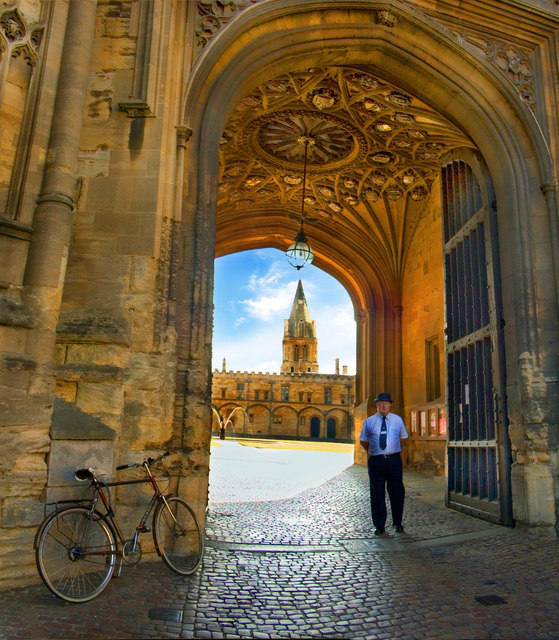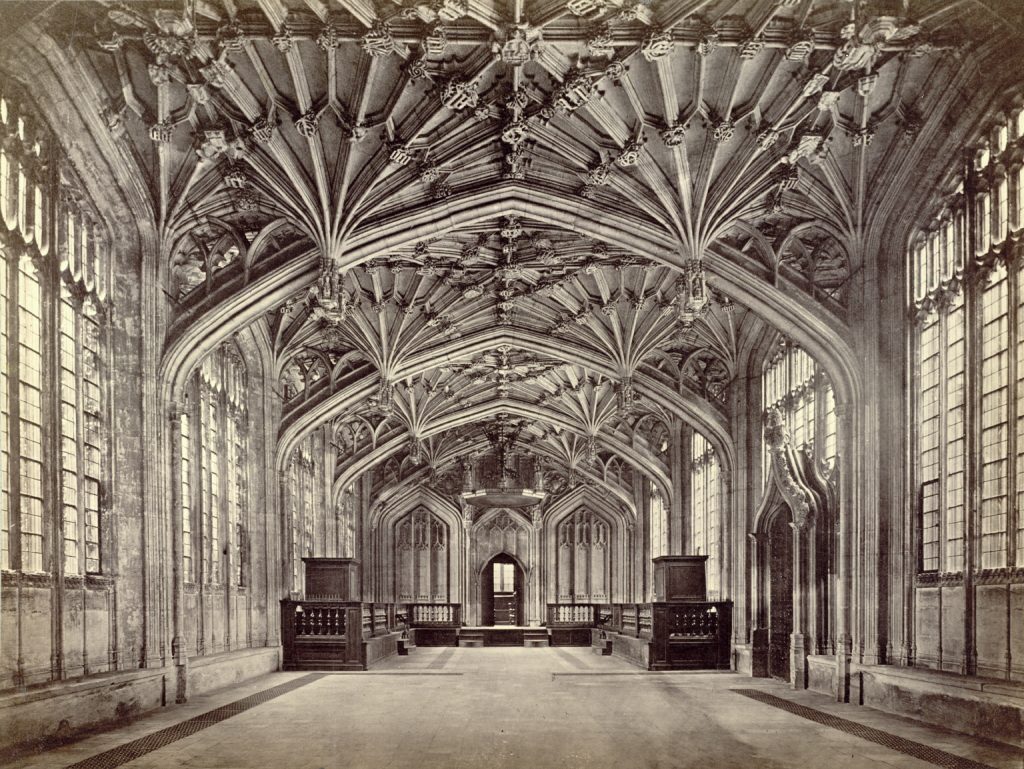
Set in Stone: How Oxford’s buildings uphold elitism
by Flo Ward | July 11, 2018
On 10 February 1355, two Oxford students drinking in the Swindlestock Tavern complained to the landlord about the quality of their wine. The fight rapidly escalated into what is known as the St Scholastica Day riot—a two-day conflict between Oxford townspeople and students which resulted in 93 deaths. In the aftermath of this violence, the colleges constructed defensive walls and buttresses to separate their students from the commoners outside. The result was a little too successful, perhaps: hundreds of years on, Oxford remains closed off to those from underprivileged backgrounds.
Oxford’s access problem has been endlessly picked apart, most recently when Labour MP David Lammy accused the university of “social apartheid” over its failure to admit state school and BME students. His shocking figures—revealing vast disparities between state and privately educated students—were published in The Guardian last October, and sparked a debate over where the blame lies: in the poor efforts of an out-of-touch university, or a lack of encouragement within state schools. The problems, however, run far deeper—they cannot simply be fixed by an admissions department or an enthusiastic state school teacher. In fact, these debates ignore how the university’s idealised image in the media is inseparable from the story of its dark, classist underbelly: Oxford’s access problem is perpetuated by its old buildings.
The average Oxford college attracts just 53% of its home applications from the state sector (a poor statistic considering 86% of UK sixth-formers are state-educated). And Oxford’s oldest colleges consistently drag this figure down. All the colleges falling below average were founded before 1700 (with the exception of St Peter’s), whereas all the colleges founded post-1800 perform above average. These old colleges—built on foundations of elitism and colonialism—remain physical reminders of an inaccessible and elitist past.

Five schools collectively send more students to Oxbridge than all of the country’s 2,000 other sixth forms and colleges put together. Four of these schools are independent, and three of them (Eton, Westminster and St Paul’s Boys) were founded pre-1600, rivalling even the historical prestige of Oxford. The university’s student body is disproportionately made up of students who have spent their teenage years in classrooms and dining halls that are just as ancient as some of Oxford’s oldest colleges, making the university’s very visible status and legacy significantly less daunting. By contrast, state comprehensive schools—a creation of the 1960s—are often uniform in their appearance, purpose-built and designed to accommodate much larger cohorts of students.
Michelle Codrington-Rogers, a teacher at Cherwell School and teachers’ union official, says that despite the fact she grew up in Oxford, “it wasn’t a place for me”. “The majority of students at our school don’t apply to Oxford because they see it as separate from them, even though we live in its shadows,” she said, speaking on a panel event organised by the campaign group Common Ground.
Although a sixth-former at any state school in Oxford could name every college and its location, independently-schooled students arrive with a sense of familiarity that outweighs this: not just through an inherited network of friends, but also because of the links between colleges and schools, which often stretch back centuries. New College and Winchester College were co-founded in 1382, with Winchester intended as a feeder school—and both were designed by the same architect, William Wynford. A similar relationship was created between Westminster School and Christ Church, with Christopher Wren responsible for much of their architecture. These relationships are therefore not just ancient: they are architecturally visible. The university’s ostensible commitment to recruiting students from every background is betrayed by its buildings, which act as stone-cold reminders of a history of elitism. Stepping inside colleges where the ratio of state school students is barely half, like New or Christ Church, is to enter a well-trodden path from feeder school through to an Oxford education—a path that has remained relatively unchanged for years.
The relationship between Oxford colleges and private schools is not just a historic relic. For schools with established links to the university, students are given literal access to buildings that would otherwise remain exclusive. A friend from a Northern state school remarked that while she was feeling overwhelmed after her matriculation ceremony, the fresher beside her was nonchalant—he’d had many school assemblies in the Sheldonian on account of attending D’Overbroecks, an independent sixth form in Oxford. In fact, Magdalen College School has also used the space for performances, while New College School allows its students an annual ‘run’ of New College. According to the school website, “they get access to some of the College’s archives and treasures, climb the tower to see its amazing views over Oxford, use the garden for fieldwork, visit surrounding historic buildings, and— many boys’ favourite—dine in the College dining hall”. What better way to demystify Oxford life than to allow students as young as four a chance to experience it? It’s a shame such opportunities are not available to all local children: New College’s Access and Admissions Administrator confirmed to me that the college has not given any tours to state primary schools in the last year.
With these links in place, students coming from independent schools are undoubtedly more likely to feel at home in Oxford’s environment—they are collaborators in the cultural history of the buildings before they even arrive. ‘Imposter syndrome’ is often bandied about amongst students here: to an extent, it is an inevitable by-product of attending a world-class institution, although it is clear some students feel more alienated than others. This alienation is not only a problem for state school students once they are here, as it also contributes to the off-putting image of Oxford that will inevitably deter applications. Several JCR access officers at older colleges told me students on tours often assume accommodation costs will be higher because of the architectural grandeur. Mia Liyanage, Balliol’s access officer, recalls a time when one student she was showing around was shocked by the college’s size, remarking “is this all still Balliol?”. “I faced the age-old access dilemma”, she tells me. “The conflict between wanting to reassure the applicant, and wanting to be realistic with them. I told him that you get used to the scale and architecture of your college quickly, but I also had to admit that Balliol is one of the physically smallest colleges in Oxford; a drop in the ocean. I have no doubt that he probably found this realisation intimidating”.

Oxford remains a stomping ground for the elite: this is evident in today’s student body, still benefiting from historic links and relationships, but also in the literal ownership of many rooms around the university. As part of fundraising schemes, many colleges ‘sell’ teaching spaces and plaques next to student bedrooms to alumni willing to make donations mounting into several thousand pounds. Over half the colleges that responded to my freedom of information requests have profited from such schemes in the past ten years, ranging from three rooms being sold at St. Hilda’s, to 183 at Keble. Defending the importance of these alumni donations, Camilla Matterson, from Keble’s Development Office, described the plaques as an “unobtrusive but meaningful way” of acknowledging donor support. There is no doubt that alumni donations are indispensable to many access schemes, often wholly funding bursaries and scholarships; yet they are more obtrusive than she suggests. Like the iconic English Heritage blue plaques in London, placing plaques next to student rooms confers on them historical and cultural importance. They become a physical reminder of the hold that the wealthy have on Oxford—quite literally branding their names onto its buildings.
While Oxford’s role in cementing class divisions is old news, the extent of the university’s foundations in colonialism are only now being addressed—it took until last December, nearly 300 years after the Codrington Library was built, for All Souls College to commission a plaque commemorating the slaves whose labour funded its construction. When I matriculated in 2016, a group of students campaigning outside the Sheldonian handed me a red square of fabric—“wear it to show your solidarity with Rhodes Must Fall”, they said. I didn’t know anything about Rhodes, and so the red square seemed just another strange Oxford tradition, no more significant than being told to wear my sub fusc ribbon. Researching the campaign afterwards perplexed me—I had just moved to Oxford from one of the most ethnically diverse areas of the UK, so I could not understand why there would be any resistance to taking down the statue of a renowned slaver.
Oriel is the most shocking example of social diversity, only managing to attract 25 per cent of its applications from the state sector between 2014-2016. The college was the subject of controversy in Lammy’s investigation for accepting only one Black British A-Level student within the last five years. We can only speculate whether the poor percentage of state school applications might have something to do with Rhodes haunting its entrance, but the college’s visible history of classism and racism undoubtedly contributes to a sense of un-belonging for the few state-schooled and non-white students studying there.
Esther Agbolade, President-Elect of the Oxford Afro-Caribbean Society and Oriel student, admits that although the college’s colonial history and architecture did not cross her mind when applying, “when I finally came to learn who exactly this Rhodes person was and that his statue lay on the other side of my wall, I felt somewhat foolish.”
“The remarks that were made whenever I told people I was going to [or] was at Oriel college made sense,” she adds. “I felt like I was the token black, female, state school student used as a cover-up for the history of the college”.

Of course, the newer Oxford colleges are hardly exempt from a lack of social diversity, but there does seem to be a relationship between college architecture and success in appealing to state school applications. The construction of St Catherine’s Old Quad and St Anne’s Rayne and Wolfson buildings in the 1960s coincided with the mass building of state schools across the UK. While the former are Grade I and II listed, and the state schools mostly imitations of their iconic Brutalist features, there remains a similarity in their openness. Kellie Harkin, JCR Access officer at St Anne’s, which was founded in 1879 and is comprised of many new buildings, notes that state school students often comment on the college being “quite a nice relief from the rest of Oxford because its somewhere they could actually imagine themselves fitting in and living”. This attitude is reflected in application statistics: Anne’s falls in the top-five best-performing colleges for attracting state school applications. On a recent school tour I gave in Catz, a teaching assistant from a state school in South East London remarked that the openness of the college was “a good way of easing students into the Oxford experience”, none of whom had been to the city before.
Surrounded by older and more traditional buildings, newer colleges can seem swamped and dismissed as less legitimately Oxonian. A particularly popular Oxfess labelled Catz “a cross between a prison and a primary school”. The post is indicative of a popular belief amongst the student body that suggests the status of newer colleges—often slightly more dominated by state school students—are secondary to the more traditional and obviously prestigious buildings. A recent proposal from the Higher Education Policy Institute called for the construction of new Oxbridge colleges designed specifically to recruit students from under-privileged backgrounds. The suggestion misses the point—several of the newer colleges initially begun in the 1800s as societies for students who could not afford traditional college fees. Their pervading perception as being less truly ‘Oxford’ is a hangover from these foundations in access. Newer, exclusively state school colleges will never be the answer when they stand in the shadow of Oxford’s oldest buildings.
If there is a way to dismantle the elitism preserved in and imposed by Oxford’s architecture without simply bulldozing it, it must involve reclaiming these spaces. Magdalen students recently voted to install a photo exhibition of current students and college staff in the dining hall—including scouts, porters and catering staff. It is an effort, Magdalen’s access officer Mia Portman, tells me, “to make it a more personal, friendly space which gives a sense of the community at Magdalen today as well as its heritage”. The motion was backed by several students who admitted that they had not originally applied to the Magdalen as a result of its intimidating facade and had “felt anxious when they found out they’d been allocated here”. Similarly, Catz is in the process of hanging new portraits in the library, replacing rows of male faces with portraits of female academic and support staff. Initiatives like these will not single-handedly change Oxford, but they will begin to overturn some of the long-standing historical baggage that comes with such an aged institution.
We can’t undo their history, but we can change the way we interact with Oxford’s buildings. They have existed for hundreds of years as the property of an elite class, but they also belong to us as much as they do to those whose ancestry is preserved in the plaques by our bedrooms and the portraits in our halls. Taking ownership of Oxford’s buildings is the only way that the spaces can become more welcoming for future generations of applicants. Esther Agbolade tells me that while her presence at Oriel at first felt tokenistic, that feeling was only temporary: “I remembered that my being here, in spite of the college’s homage to a man who didn’t want me here, has already inspired so many young people I know of and probably more that I don’t. The college is more than the building. I am happy at Oriel, whether Rhodes would have liked it or not.”




